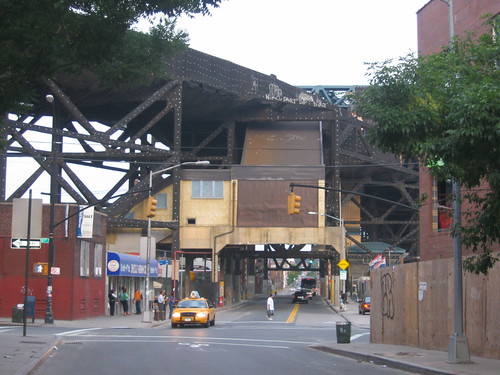
A real F express plan would involve a costly renovation of the lower level at Bergen St., shown here in 2000. (Photo via NYCSubway.org)
But there’s another story in the document, one regarding money and a desire to provide better service. It’s the story of how the MTA could make F express service if not more palatable for some areas in Brooklyn, at least more justifiable for certain stations. It involves a lesson in late 1990s subway history and approximately $100 million. We start in March of 1999 when a fire destroyed a 70-year-old switch control panel at Bergen St. The MTA was able to restore service to the station faster than expected, but repairs to the control panel weren’t completed until 2007. At this point, the lower level isn’t a functional passenger station.
To realize the best possible F express routing, restoring Bergen St. is essential. The station sees nearly 12,000 passengers per day, and by providing express service at Bergen St., many passengers who will lose service if the express plan is implemented would be spared that fate. But the MTA says this work is far too expensive. The agency would have to include accessibility upgrades to bring Bergen St. into compliance with the ADA; reconstructing stairs, platforms and station finishes; install communications and electrical systems; relocate cables; and restore signals that weren’t included in post-fire restoration work. The cost would top $75 million, and that is, apparently, $75 million the MTA does not have.
Meanwhile, at both Bergen and Carroll Sts., the MTA contemplated the queueing issues that could arise if the express plan is implemented. More crowded local trains means more congested station entrances. The MTA anticipates that riders would have to wait, on average, 32 seconds more to reach the stairs at Bergen St. and approximately 10 seconds more to reach the stairs at Carroll St. “This does not,” the MTA notes, “account for the modest amount of counter-flow that currently exists, which would further delay exiting riders.” Widening staircases and installing one elevator at each stop would cost at least $20 million, the MTA estimates. (The MTA doesn’t really address passengers transferring between the R line and theF train at 4th Ave.-9th Sts., another potential chokepoint that could negatively impact commute times or the effects this new service has on Red Hook, a true transit-starved area.)
At least part of this $100 million expense — widening the staircases, making Carroll and Bergen ADA-compliant — should be included in any final F express plan, but if the MTA wants to do it right, the full rehabilitation of the lower level at Bergen Street should be a pre-requisite. That would make this proposal, warts and all, a bit easier to take even as the gold standard remains maintaining F local frequencies while adding some level of express service.


 The F line, much maligned and often overcrowded, is near and dear to my heart. I live nearby the stop at 7th Ave. in Brooklyn and often find myself relying on it for travel to and from home and parts of Brooklyn or Manhattan. A few years ago, securing
The F line, much maligned and often overcrowded, is near and dear to my heart. I live nearby the stop at 7th Ave. in Brooklyn and often find myself relying on it for travel to and from home and parts of Brooklyn or Manhattan. A few years ago, securing 


